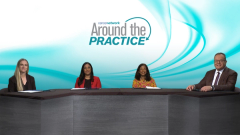
First-Line Treatment Options in Transplant-Ineligible NDMM
Dr Caitlin Costello presents the case of a patient with transplant-ineligible multiple myeloma and sparks a conversation on the available treatment regimens.
Episodes in this series

Rafael Fonseca, MD: Dr Costello, go through your case.
Caitlin Costello, MD: This is a patient we consider to be transplant ineligible, as opposed to the transplant-eligible patient we just reviewed. Let’s talk about an 81-year-old man. He has a history of diabetes and hypertension. A routine laboratory work-up revealed some renal insufficiency. As part of that work-up, his nephrologist checked some serum free light chains and found that the lambda level was elevated at approximately 9500 mg/L. Further work-up of this included a PET [positron emission tomography]–CT, which showed that there was positive uptake in several ribs, and a collapse of T7. On further review, the patient reported ongoing and progressive back pain.
This patient has now been diagnosed with multiple myeloma, a lambda light chain secreting disease, and based on further laboratory results showed no extramedullary disease by imaging, had an ISS [International Staging System] stage III or Revised ISS stage II. After discussion with this patient, based on his age and comorbidities, he was deemed ineligible for transplant. Based on that, a discussion reviewed daratumumab, lenalidomide, and dexamethasone as an option for treatment based on the MAIA trial. The patient started on this treatment and achieved a stringent complete response after 6 months.
As we were previously reviewing some of the adverse effects that we can see with some of these treatments, as expected to some degree, this patient had mild neutropenia, moderate fatigue, and intermittent diarrhea, which were discussed at his subsequent appointments. Through those appointments and discussions, we evaluated options, including dose reduction of the lenalidomide as presumably the cause of some of the symptoms that he was having, which helped improve some of these treatment-related adverse events. One trick many of us use is to look for cholestyramine as a treatment of that drug-induced diarrhea with lenalidomide, which can be quite effective for these patients. With these dose reductions, the patient was able to tolerate it better and continue on therapy. He has continued on daratumumab, lenalidomide, and dexamethasone for over 2 years and remains in a stringent complete remission.
Rafael Fonseca, MD: Thank you. Let’s talk a little about transplant-ineligible patients. I’m going to date myself. When I was in training, there was a pretyped prescription pad that used melphalan and prednisone. You just had to put in the dose for melphalan—this was pre–Epic [electronic health record]. Essentially, plateau was our goal. Then we went through all those transformations, the addition of IMiDs [immunomodulatory imide drug], and the subsequent studies by Dr [Maria-Victoria] Mateos of VMP [bortezomib, melphalan, prednisone] in ALCYONE. That led us to the modern trials, VRd [bortezomib, lenalidomide, dexamethasone] through SWOG S0777—we’ll talk more about that—as well as the MAIA clinical trial. It’s critically important in how we decide treatment for this patient.
Dr Patel, what factors come into your mind as you think about treatment selection for this patient population?
Krina Patel, MD: The definition of frailty might be a little different, even among us. We’re probably really aggressive at [The University of Texas] MD Anderson [Cancer Center] in saying that most patients could probably get through transplant. Renal insufficiency isn’t a reason for transplant ineligibility. But with this older patient who has other comorbidities, with older patients or younger, more frail patients, you think about polypharmacy. If they’re taking 5-plus drugs, they’re probably at a higher risk of other adverse effects and toxicity. Performance status also tells you a lot.
When a patient can’t walk into my room because they’re in a wheelchair—not because of the myeloma—or they have bad neuropathy, we don’t think we’re going to reverse that. They’re at higher risk of infections. At MD Anderson, the majority of patients are probably eligible for transplant. But if I’m worried about their induction therapy causing problems, I’m not going to take them to transplant.
Rafael Fonseca, MD: Frailty is such an important factor. At ASCO [American Society of Clinical Oncology Annual Meeting] 2 or 3 years ago, there was a gap in my schedule. I went into the session saying, “This is going to be the most boring session. Who wants to talk about this?” I was blown away by the effect of frailty on outcomes in older patients. It was superior to what we see with genetics.
Krina Patel, MD: Exactly.
Rafael Fonseca, MD: It’s important for us to think that way as we approach this patient. Dr Costello, we’ve seen a few presentations and updates about MAIA, the most recent being at IMS [International Myeloma Society Annual Meeting]. What are your thoughts on the response rate, MRD, and so forth?
Caitlin Costello, MD: The MAIA study compared the triplet of daratumumab-lenalidomide-dexamethasone, as in this patient, with the doublet of lenalidomide-dexamethasone. For many years, we’ve had more data come out that keep looking better. We finally had a great PFS [progression-free survival] difference between a triplet and a doublet, and then we got the overall survival benefit. We’re saving lives by putting our older, potentially frailer patients on this triplet regimen, as opposed to SWOG.
This was an older group. This was a truly transplant-ineligible population as opposed to patients who have deferred transplant. This is very relevant for thinking about patient like this. If we’re improving PFS and survival, we want to balance toxicity with the success of the treatment. The questions come up about quality of life and show that the toxicity is manageable with daratumumab. We’re getting more updates as the data continue to mature.
After many years, 1 question that’s asked often by patients is: “Do I need to continue on treatment? Can I make some adjustments? Lenalidomide is hard, with the diarrhea and fatigue. Can I just stay on daratumumab?” One study presented at IMS this year was looking at duration. Is there an appropriate duration or most effective duration for staying on the triplet? Staying on the triplet for at least 9 but preferably 18 months showed the improvement in the PFS that we were looking for. We’re seeing deep responses overall, but if we can keep these patients on a good 18 months of therapy, they’re going to continue to reap some of the benefits of it.
Rafael Fonseca, MD: Critical point. No. 1 is the age. The median age was 73 for MAIA. These are truly representative for the older population. The other thing that you mentioned is something I’ve been asking patients more. As physicians, we think maintenance is going to appeal as simpler, but many more patients say, “I’ll come here once a month and get my shot rather than have to deal with IMiD toxicity.” IMiDs were transformational in how we think about myeloma. We’re putting them into the second row because of how well patients can tolerate the injections of daratumumab.
Newsletter
Stay up to date on recent advances in the multidisciplinary approach to cancer.























































































